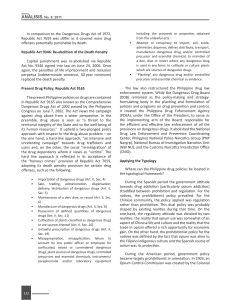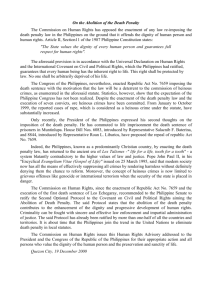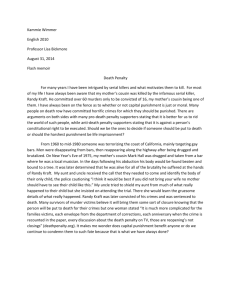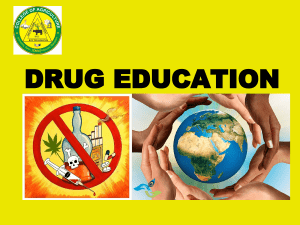ANÁLISIS
advertisement
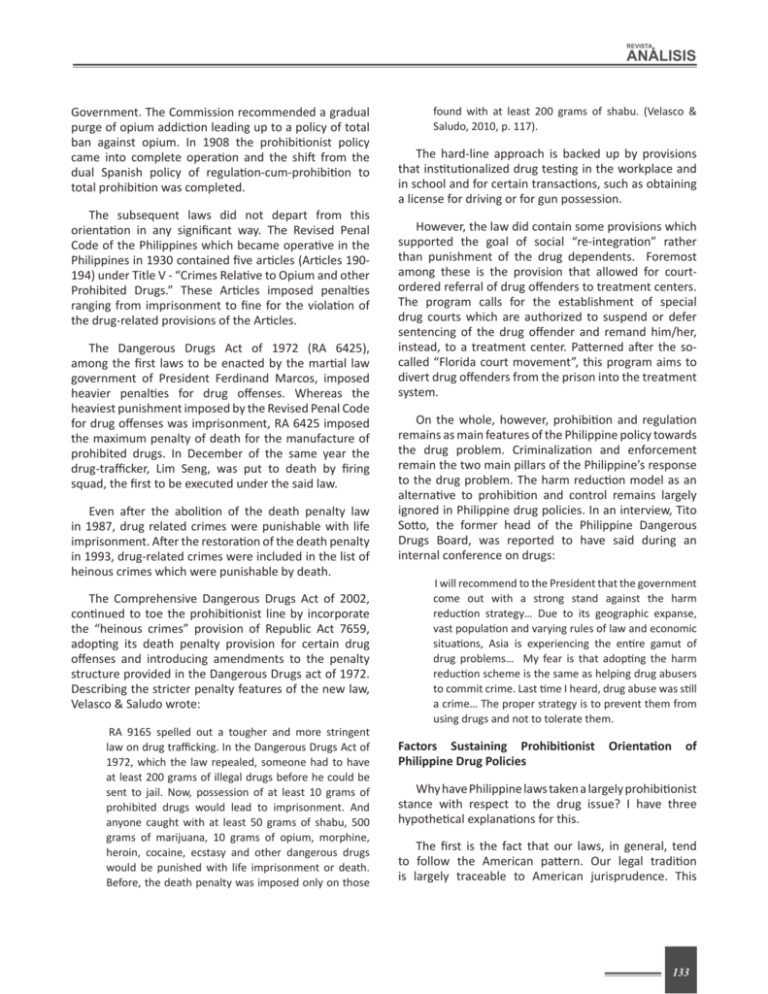
REVISTA ANÁLISIS Government. The Commission recommended a gradual purge of opium addiction leading up to a policy of total ban against opium. In 1908 the prohibitionist policy came into complete operation and the shift from the dual Spanish policy of regulation-cum-prohibition to total prohibition was completed. The subsequent laws did not depart from this orientation in any significant way. The Revised Penal Code of the Philippines which became operative in the Philippines in 1930 contained five articles (Articles 190194) under Title V - “Crimes Relative to Opium and other Prohibited Drugs.” These Articles imposed penalties ranging from imprisonment to fine for the violation of the drug-related provisions of the Articles. The Dangerous Drugs Act of 1972 (RA 6425), among the first laws to be enacted by the martial law government of President Ferdinand Marcos, imposed heavier penalties for drug offenses. Whereas the heaviest punishment imposed by the Revised Penal Code for drug offenses was imprisonment, RA 6425 imposed the maximum penalty of death for the manufacture of prohibited drugs. In December of the same year the drug-trafficker, Lim Seng, was put to death by firing squad, the first to be executed under the said law. Even after the abolition of the death penalty law in 1987, drug related crimes were punishable with life imprisonment. After the restoration of the death penalty in 1993, drug-related crimes were included in the list of heinous crimes which were punishable by death. The Comprehensive Dangerous Drugs Act of 2002, continued to toe the prohibitionist line by incorporate the “heinous crimes” provision of Republic Act 7659, adopting its death penalty provision for certain drug offenses and introducing amendments to the penalty structure provided in the Dangerous Drugs act of 1972. Describing the stricter penalty features of the new law, Velasco & Saludo wrote: RA 9165 spelled out a tougher and more stringent law on drug trafficking. In the Dangerous Drugs Act of 1972, which the law repealed, someone had to have at least 200 grams of illegal drugs before he could be sent to jail. Now, possession of at least 10 grams of prohibited drugs would lead to imprisonment. And anyone caught with at least 50 grams of shabu, 500 grams of marijuana, 10 grams of opium, morphine, heroin, cocaine, ecstasy and other dangerous drugs would be punished with life imprisonment or death. Before, the death penalty was imposed only on those found with at least 200 grams of shabu. (Velasco & Saludo, 2010, p. 117). The hard-line approach is backed up by provisions that institutionalized drug testing in the workplace and in school and for certain transactions, such as obtaining a license for driving or for gun possession. However, the law did contain some provisions which supported the goal of social “re-integration” rather than punishment of the drug dependents. Foremost among these is the provision that allowed for courtordered referral of drug offenders to treatment centers. The program calls for the establishment of special drug courts which are authorized to suspend or defer sentencing of the drug offender and remand him/her, instead, to a treatment center. Patterned after the socalled “Florida court movement”, this program aims to divert drug offenders from the prison into the treatment system. On the whole, however, prohibition and regulation remains as main features of the Philippine policy towards the drug problem. Criminalization and enforcement remain the two main pillars of the Philippine’s response to the drug problem. The harm reduction model as an alternative to prohibition and control remains largely ignored in Philippine drug policies. In an interview, Tito Sotto, the former head of the Philippine Dangerous Drugs Board, was reported to have said during an internal conference on drugs: I will recommend to the President that the government come out with a strong stand against the harm reduction strategy… Due to its geographic expanse, vast population and varying rules of law and economic situations, Asia is experiencing the entire gamut of drug problems… My fear is that adopting the harm reduction scheme is the same as helping drug abusers to commit crime. Last time I heard, drug abuse was still a crime… The proper strategy is to prevent them from using drugs and not to tolerate them. Factors Sustaining Prohibitionist Philippine Drug Policies Orientation of Why have Philippine laws taken a largely prohibitionist stance with respect to the drug issue? I have three hypothetical explanations for this. The first is the fact that our laws, in general, tend to follow the American pattern. Our legal tradition is largely traceable to American jurisprudence. This 133



